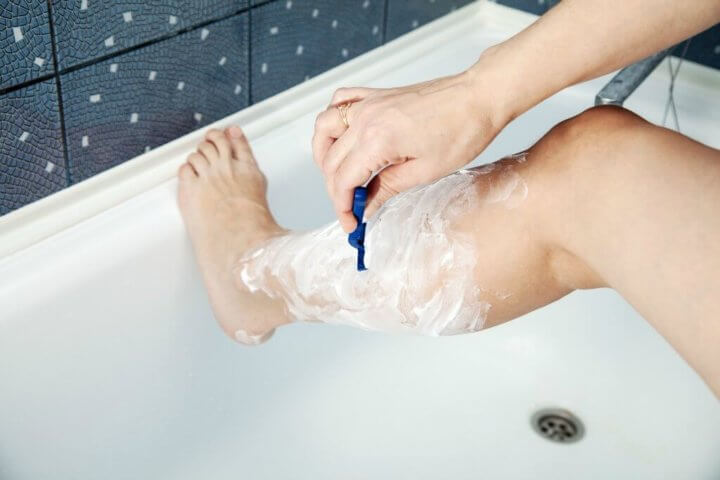
When I was first asked to write this article, I jumped at the chance. However, I found that each time I sat down to start writing, I was blocked. Had I lost my fire for shaving? The empty feelings that had replaced my once passionate mind about shaving reminded me of when I first discovered traditional wet shaving back in 2010.
Back then I found shaving to be a chore. My underarms and legs were always dried out and irritated by the can of foam and plastic handled razor with the gooey strip that I used religiously. My skin was constantly burning yet I kept on shaving; because I was supposed to.
I recall how I felt if any part of my seen body was left unshaven and, my preliminary research on the subject still left something to be desired. Basically shamed into shaving since the early 1920’s, women across the globe would rather wear pants than show off a leg with stubble. We were told in advertorial that having hair on the face, arms and legs was a disfigurement – that we didn’t belong in society; and over time the subject became taboo and as a society we began to believe it.
Talking with my girlfriends I realized, I was not alone. Many of my ladies would rather endure the pain of rashes and irritation than be seen in public with anything less than smooth skin. Some had ditched shaving all together and elected to have their hair ripped out at the root using painful waxes or pay top dollar for electrolysis, dishing out big bucks time and time again to stay smooth.
Even though a lot has changed since the 1920’s, when it comes to shaving we’re still in the dark ages. Most women still will not participate in conversations about shaving, and find to be an utterly embarrassing conversation, even with their closest friends.
For the past seven years I’ve discovered that women don’t know what to tell their daughters as they come of age; knowing how painful the entire experience can be and would rather deter them from shaving altogether than work with them to find a solution to the nicks, cuts and unbelievable dissatisfaction most experience while shaving.
For most of us, we enter our local market or pharmacy and stare blankly at the cookie cutter options provided on the shelf. We ask ourselves which can of goo is the best and how many layers of blades do I need to shave adequately? Razors available to the masses boast about lubricating strips and seven layers of sharp metal that allege a closer shave.
The truth is, chemical strips and foam can irritate the skin more than help provide protection and seven layers of blades equates to seven layers of exfoliation. Especially for someone with sensitive skin, it’s too much! It can be THE contributing factor to why your skin is red and irritated, requiring more time to heal.
To truly simplify your shave, and give your skin a rest you need a single sharp blade and quality soap. Using a brush can help you to prep the skin, exfoliating the top layer of your epidermis and making the hair stand up to be cut efficiently in one pass. This type of shaving reigned supreme for years until being replaced by heavy disposable plastic with heavier price tag, and the marketing we now experience that shames us into cluttering our landfills and providing popular shaving companies with more equity.
What is Traditional Wet Shaving?
Traditional wet shaving has many meanings to people but to me it simply means shaving with water using something other than an electric or disposable. Traditional wet shaving razors will require sharpening, or will have a removable blade.
Why Should You Switch?
If you’ve experienced any of the symptoms I described above, you should consider changing to traditional wet shaving. In my tenure as a wet shaver I’ve experienced a huge change in my skin’s quality and comfort. Since changing to a double-edge safety razor with soap with brush application, my skin is smoother and more radiant. Not only does is look and feel nicer, I used to have to shave religiously every day. Now, I shave twice a week.
In addition to the comfort of a traditional wet shave, I am personally motivated by the reduction of my carbon footprint. I usually reach for my safety razor which reduces the amount of shaving gear I put in a landfill each year by 70%, which adds up yearly.
What Tools Will You Need?
The tools for a traditional wet shave are simple and include a safety razor, blade, shaving soap and brush. When getting started, you can easily replace just one piece of your current shaving regimen or all of them. For anyone with sensitive skin, I always recommend going slow – and choosing products that are more natural, especially in shaving soaps. Several artisan companies available online make products out of coconut oil, which is easy on the skin and super nourishing.
Razor Options:
The Double-edge Safety Razor: Also known as a DE, takes safety razor blades so you have a razor head with two blade options that sit across from each other. Some very popular DE options today are made by Feather, Merkur and Parker.
The Single-edge Safety Razor: Similar to the DE, the Single edge, or SE has one side for shaving. Blades can be harder to come by but are available from several online retailers in surgical grade. You’ll want to be certain that the blades are sharp. The Mongoose and OneBlade razors are very popular single-edge options.
The Straight Razor: A straight razor is a razor with a sharpen-able blade that can fold into its handle. They are also called open razors or cut-throat razors. Straight razors are available almost exclusively online and will require sharpening of the cutting edge. A popular alternative to the straight razor, but with a removable blade is called a shavette. Barbers use a shavette when shaving people because it does not require sharpening and is more hygienic because of the removable blade.
The Shaving Brush:
Brushes can be found in a variety of styles online from large scale manufacturers like Edwin Jagger, to smaller artisan brushes found on sites like Etsy. The “knot” or hair of a shaving brush can vary from badger, horse and boar to my personal favorite, the vegan or synthetic knot. The shaving brush knot is held together by a handle and can be the signature piece of your shaving collection.
The Blade:
Many companies, including Gillette, make blades for traditional wet shaving. Recommending a blade can be like recommending tennis shoes; it varies per individual based on your comfort level. Some of my favorite blades include Rockwell Razors and Gillette Platinum, although there are many more that I have tried and loved. For beginners, I recommend the online site www.tryablade.com for their variety and options. For instance, when ordering from Try a Blade, you can get starter packs with only one of each blade, so you are not locked into a whole pack – try one, if you like it buy more. With most other online retailers you have to purchase 5-10 blade packs and sometimes they go to waste. Several retailers also offer whats known as ‘sample packs’ that will give you a variety of starter blades to try out and evaluate.
Choosing Your Gear
Let’s be honest, most of us are going to choose our gear based on aesthetics, or what it looks like. As you get more and more into choosing options for yourself, you’ll start to factor in specifics of your gear such as weight, handle length and country of origin. I personally love gear that’s made in the USA, even paying a few dollars more for it. My advice is this: do your research online and see what you like. Most companies offer starter kits for beginners and they’re a great place to begin that doesn’t break the bank. Ideally, switching to traditional wet shaving should shave you money, unless you become a collector like myself – having over 100 different kinds of razors both new and vintage.
For ladies, I highly recommend your first razor have a longer handle, like the Merkur 23C or a vintage Lady Gillette. The longer handle is easier to hold on to and the weight of both razors isn’t too heavy.
Shaving Soaps, Creams and Accouterments
Again, most of us are going to choose a soap with a scent that we prefer. I personally love lavender soaps and reach for them 8 out of 10 shaves but, there are a few artisan companies that make scents like Fougere Noir (based on the cologne Draakar Noir) which I LOVE. It reminds me of being in junior high school and the boy I crushed on who wore it. Many of the fellas will tell you that some scents are made for men versus women, I wholly disagree. I say if you like it, try it. After all, its all about skin.
Note: If you ever experience any irritation with any products, I recommend you discontinue use. When starting out it can be helpful to keep a journal of the gear and scents you’ve tried, especially if you have sensitive skin. Sometimes you’ll experience irritation from an entire line of products, which will tell you its something in the soap base that gives your discomfort. Often times, a certain scent will be the irritant, like Pine. The journal will help you to compare to avoid any irritations in the future.
Whether you change one item in your shaving routine, or all of them remember to take your time and enjoy your shave – in a world where we are being pulled in many directions all at once, take back your power and your comfort. Light some candles, take a deep breath and pamper yourself. You’ll be glad you did.
About the author:
 TK Gray, affectionately known in the wet shaving community as The Razor Queen, has been a vintage razor expert and techniques coach since 2010. TK holds two VMBA’s and her tenure in business has lead her to work with a variety of notable names, such as Trump Industries and Madison Avenue Agency. TK currently lives in her home state of Connecticut.
TK Gray, affectionately known in the wet shaving community as The Razor Queen, has been a vintage razor expert and techniques coach since 2010. TK holds two VMBA’s and her tenure in business has lead her to work with a variety of notable names, such as Trump Industries and Madison Avenue Agency. TK currently lives in her home state of Connecticut.

I’m so glad to see this article. I’ve been using a DE to shave my legs for a few years now and I love it.
Comments are closed.